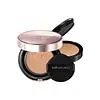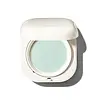What's inside
What's inside
 Key Ingredients
Key Ingredients

 Benefits
Benefits

 Concerns
Concerns

 Ingredients Side-by-side
Ingredients Side-by-side

Water
Skin ConditioningCI 77891
Cosmetic ColorantDimethicone
EmollientEthylhexyl Methoxycinnamate
UV AbsorberEthylhexyl Salicylate
UV AbsorberMethyl Trimethicone
Skin ConditioningGlycerin
HumectantButylene Glycol Dicaprylate/Dicaprate
EmollientDiphenylsiloxy Phenyl Trimethicone
Skin ConditioningLauryl PEG-10 Tris(Trimethylsiloxy)Silylethyl Dimethicone
EmulsifyingButylene Glycol
HumectantDiisostearyl Malate
EmollientNiacinamide
SmoothingPentylene Glycol
Skin ConditioningSynthetic Fluorphlogopite
Cyclopentasiloxane
EmollientCI 77492
Cosmetic ColorantCetyl Dimethicone
EmollientCetyl PEG/PPG-10/1 Dimethicone
EmulsifyingDiglycerin
Humectant1,2-Hexanediol
Skin ConditioningDisteardimonium Hectorite
StabilisingAcrylates/Stearyl Acrylate/Dimethicone Methacrylate Copolymer
Magnesium Sulfate
Phenoxyethanol
PreservativeDimethicone Crosspolymer
Emulsion StabilisingLauroyl Lysine
Skin ConditioningStearic Acid
CleansingCI 77491
Cosmetic ColorantAlumina
AbrasivePolyhydroxystearic Acid
EmulsifyingAluminum Hydroxide
EmollientTriethoxycaprylylsilane
CI 77499
Cosmetic ColorantIsododecane
EmollientOctyldodecanol
EmollientPolymethylsilsesquioxane
Propanediol
SolventPEG-9 Polydimethylsiloxyethyl Dimethicone
EmulsifyingParfum
MaskingEthylhexylglycerin
Skin ConditioningEthylhexyl Palmitate
EmollientIsopropyl Myristate
EmollientIsostearic Acid
CleansingLecithin
EmollientAdenosine
Skin ConditioningTrisodium Ethylenediamine Disuccinate
Polyglyceryl-3 Polyricinoleate
EmulsifyingOpuntia Ficus-Indica Fruit Extract
Skin ConditioningPolypropylsilsesquioxane
Polyglyceryl-4 Isostearate
EmulsifyingBenzyl Glycol
SolventIsopropyl Titanium Triisostearate
EmollientHydrolyzed Glycosaminoglycans
HumectantSodium Hyaluronate
HumectantCalcium Sodium Borosilicate
Trimethylsiloxysilicate
EmollientSodium Hyaluronate Crosspolymer
HumectantHydrolyzed Hyaluronic Acid
HumectantCholesteryl Chloride
Skin ConditioningCholesteryl Isostearate
EmollientCholesteryl Nonanoate
EmollientTocopherol
AntioxidantDiamond Powder
AbrasiveHydroxypropyltrimonium Hyaluronate
Hyaluronic Acid
HumectantBHT
AntioxidantSilica
AbrasiveSodium Acetylated Hyaluronate
HumectantWater, CI 77891, Dimethicone, Ethylhexyl Methoxycinnamate, Ethylhexyl Salicylate, Methyl Trimethicone, Glycerin, Butylene Glycol Dicaprylate/Dicaprate, Diphenylsiloxy Phenyl Trimethicone, Lauryl PEG-10 Tris(Trimethylsiloxy)Silylethyl Dimethicone, Butylene Glycol, Diisostearyl Malate, Niacinamide, Pentylene Glycol, Synthetic Fluorphlogopite, Cyclopentasiloxane, CI 77492, Cetyl Dimethicone, Cetyl PEG/PPG-10/1 Dimethicone, Diglycerin, 1,2-Hexanediol, Disteardimonium Hectorite, Acrylates/Stearyl Acrylate/Dimethicone Methacrylate Copolymer, Magnesium Sulfate, Phenoxyethanol, Dimethicone Crosspolymer, Lauroyl Lysine, Stearic Acid, CI 77491, Alumina, Polyhydroxystearic Acid, Aluminum Hydroxide, Triethoxycaprylylsilane, CI 77499, Isododecane, Octyldodecanol, Polymethylsilsesquioxane, Propanediol, PEG-9 Polydimethylsiloxyethyl Dimethicone, Parfum, Ethylhexylglycerin, Ethylhexyl Palmitate, Isopropyl Myristate, Isostearic Acid, Lecithin, Adenosine, Trisodium Ethylenediamine Disuccinate, Polyglyceryl-3 Polyricinoleate, Opuntia Ficus-Indica Fruit Extract, Polypropylsilsesquioxane, Polyglyceryl-4 Isostearate, Benzyl Glycol, Isopropyl Titanium Triisostearate, Hydrolyzed Glycosaminoglycans, Sodium Hyaluronate, Calcium Sodium Borosilicate, Trimethylsiloxysilicate, Sodium Hyaluronate Crosspolymer, Hydrolyzed Hyaluronic Acid, Cholesteryl Chloride, Cholesteryl Isostearate, Cholesteryl Nonanoate, Tocopherol, Diamond Powder, Hydroxypropyltrimonium Hyaluronate, Hyaluronic Acid, BHT, Silica, Sodium Acetylated Hyaluronate
Silica
AbrasiveCaprylic/Capric Triglyceride
MaskingDimethicone/Vinyl Dimethicone Crosspolymer
Skin ConditioningMethicone
EmollientWater
Skin ConditioningChamomilla Recutita Flower Water
MaskingEthylhexylglycerin
Skin ConditioningGlyceryl Caprylate
EmollientButylene Glycol
HumectantMentha Arvensis Leaf Extract
MaskingDipotassium Glycyrrhizate
Humectant1,2-Hexanediol
Skin ConditioningHydrolyzed Hyaluronic Acid
HumectantHydrolyzed Corn Starch
HumectantPinus Densiflora Leaf Extract
AntimicrobialTocopherol
AntioxidantDisodium EDTA
Silica, Caprylic/Capric Triglyceride, Dimethicone/Vinyl Dimethicone Crosspolymer, Methicone, Water, Chamomilla Recutita Flower Water, Ethylhexylglycerin, Glyceryl Caprylate, Butylene Glycol, Mentha Arvensis Leaf Extract, Dipotassium Glycyrrhizate, 1,2-Hexanediol, Hydrolyzed Hyaluronic Acid, Hydrolyzed Corn Starch, Pinus Densiflora Leaf Extract, Tocopherol, Disodium EDTA
 Reviews
Reviews

Ingredients Explained
These ingredients are found in both products.
Ingredients higher up in an ingredient list are typically present in a larger amount.
1,2-Hexanediol is a synthetic liquid and another multi-functional powerhouse.
It is a:
- Humectant, drawing moisture into the skin
- Emollient, helping to soften skin
- Solvent, dispersing and stabilizing formulas
- Preservative booster, enhancing the antimicrobial activity of other preservatives
Butylene Glycol (or BG) is used within cosmetic products for a few different reasons:
Overall, Butylene Glycol is a safe and well-rounded ingredient that works well with other ingredients.
Though this ingredient works well with most skin types, some people with sensitive skin may experience a reaction such as allergic rashes, closed comedones, or itchiness.
Learn more about Butylene GlycolEthylhexylglycerin (we can't pronounce this either) is commonly used as a preservative and skin softener. It is derived from glyceryl.
You might see Ethylhexylglycerin often paired with other preservatives such as phenoxyethanol. Ethylhexylglycerin has been found to increase the effectiveness of these other preservatives.
Hydrolyzed Hyaluronic Acid is a form of hyaluronic acid. It is created by the hydrolysis of hyaluronic acid with a high molecular weight. Once created, Hydrolyzed Hyaluronic Acid has a low molecular weight.
Low molecular weight HA has been shown to hydrate and increase elasticity of the skin. Increasing elasticity is also associated with reduction of wrinkle depth.
One study found topical low molecular weight hyaluronic acid may be considered for the treatment of rosacea in the adult population. However, we always recommend speaking with a professional about your skin concerns.
Hyaluronic acids are a humectant. This means they draw moisture from the air. Hyaluronic acids help moisturize, soothe, and protect the skin.
Read more about other common forms of hyaluronic acid:
Learn more about Hydrolyzed Hyaluronic AcidSilica, also known as silicon dioxide, is a naturally occurring mineral. It is used as a fine, spherical, and porous powder in cosmetics.
Though it has exfoliant properties, the function of silica varies depending on the product.
The unique structure of silica enhances the spreadability and adds smoothness, making it a great texture enhancer.
It is also used as an active carrier, emulsifier, and mattifier due to its ability to absorb excess oil.
In some products, tiny microneedles called spicules are made from silica or hydrolyzed sponge. When you rub them in, they lightly polish away dead skin layers and enhance the penetration of active ingredients.
Learn more about SilicaTocopherol (also known as Vitamin E) is a common antioxidant used to help protect the skin from free-radicals and strengthen the skin barrier. It's also fat soluble - this means our skin is great at absorbing it.
Vitamin E also helps keep your natural skin lipids healthy. Your lipid skin barrier naturally consists of lipids, ceramides, and fatty acids. Vitamin E offers extra protection for your skin’s lipid barrier, keeping your skin healthy and nourished.
Another benefit is a bit of UV protection. Vitamin E helps reduce the damage caused by UVB rays. (It should not replace your sunscreen). Combining it with Vitamin C can decrease sunburned cells and hyperpigmentation after UV exposure.
You might have noticed Vitamin E + C often paired together. This is because it is great at stabilizing Vitamin C. Using the two together helps increase the effectiveness of both ingredients.
There are often claims that Vitamin E can reduce/prevent scarring, but these claims haven't been confirmed by scientific research.
Learn more about TocopherolWater. It's the most common cosmetic ingredient of all. You'll usually see it at the top of ingredient lists, meaning that it makes up the largest part of the product.
So why is it so popular? Water most often acts as a solvent - this means that it helps dissolve other ingredients into the formulation.
You'll also recognize water as that liquid we all need to stay alive. If you see this, drink a glass of water. Stay hydrated!
Learn more about Water